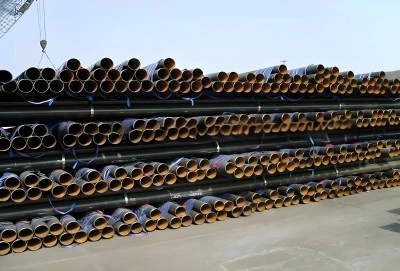In the world of oil and gas transportation, the choice of pipeline material is crucial for ensuring safety, efficiency, and longevity. One of the most commonly used pipe grades in the industry is API 5L X42 PSL1. But can this grade of pipe withstand the demands of high-pressure transmission? Let's delve into the characteristics, pressure ratings, and industry standards of API 5L X42 PSL1 pipe to answer this important question.
|
|
|
What are the pressure ratings of API 5L X42 PSL1 Pipe?
API 5L X42 PSL1 pipe is a carbon steel grade designed for various applications in the oil and gas industry. The "X42" designation indicates that the pipe has a minimum yield strength of 42,000 psi (290 MPa), while "PSL1" refers to Product Specification Level 1, which is the standard level of manufacturing requirements and testing.
When it comes to pressure ratings, API 5L X42 PSL1 pipe is generally considered suitable for low to medium pressure applications. The exact pressure rating depends on several factors, including:
- Wall thickness
- Pipe diameter
- Temperature of operation
- Safety factors applied in the design
Typically, API 5L X42 PSL1 pipe can handle pressures ranging from 740 psi (5.1 MPa) to 1,480 psi (10.2 MPa) for standard wall thicknesses. However, it's important to note that these are general figures, and the actual pressure rating for a specific application should be calculated based on the pipe's dimensions and the project's design parameters.
For instance, a 12-inch diameter API 5L X42 PSL1 pipe with a wall thickness of 0.375 inches might have a maximum allowable operating pressure (MAOP) of around 1,000 psi (6.9 MPa) under normal operating conditions. However, this can vary depending on the specific design factors and safety margins applied in the project.
How does API 5L X42 PSL1 compare with higher-grade pipes in high-pressure applications?
When comparing API 5L X42 PSL1 pipe with higher-grade pipes for high-pressure applications, several factors come into play:
1. Strength: API 5L X42 PSL1 has a minimum yield strength of 42,000 psi (290 MPa). In contrast, higher grades like X52, X65, or X70 have minimum yield strengths of 52,000 psi (360 MPa), 65,000 psi (450 MPa), and 70,000 psi (485 MPa) respectively. This means that higher-grade pipes can generally withstand greater internal pressures without deforming.
2. Wall Thickness: To achieve the same pressure rating as higher-grade pipes, API 5L X42 PSL1 pipes often require thicker walls. This can result in heavier pipes, which may increase transportation and installation costs.
3. Cost: Generally, API 5L X42 PSL1 pipe is less expensive than higher-grade pipes due to its lower strength requirements and more straightforward manufacturing process. However, the need for thicker walls in high-pressure applications can offset some of these cost savings.
4. Weldability: API 5L X42 PSL1 pipe typically has good weldability due to its lower carbon equivalent. Higher-grade pipes may require more specialized welding procedures and skilled welders, especially for field joints.
5. Toughness: Higher-grade pipes often have better toughness properties, which can be crucial in high-pressure applications where resistance to crack propagation is important.
For example, in a high-pressure natural gas transmission pipeline operating at 1,500 psi (10.3 MPa), an engineer might choose API 5L X65 over X42 PSL1. The X65 grade would allow for a thinner wall thickness while still meeting the pressure requirements, potentially reducing material costs and improving flow characteristics.
Is API 5L X42 PSL1 Pipe compliant with industry standards for high-pressure transmission?
API 5L X42 PSL1 pipe is manufactured in compliance with the American Petroleum Institute's Specification 5L, which is a widely recognized industry standard for line pipe. However, compliance with this standard alone does not automatically qualify the pipe for high-pressure transmission applications.
When considering the use of API 5L X42 PSL1 pipe for high-pressure transmission, several factors must be taken into account:
1. Design Codes: High-pressure transmission pipelines are typically designed according to specific codes such as ASME B31.4 for liquid petroleum transportation or ASME B31.8 for gas transmission and distribution piping systems. These codes provide guidelines for the selection of appropriate materials based on operating pressures, temperatures, and other factors.
2. Regulatory Requirements: Different regions and countries may have specific regulations governing the use of pipeline materials for high-pressure transmission. For example, in the United States, the Pipeline and Hazardous Materials Safety Administration (PHMSA) sets requirements for pipeline materials and design.
3. Project Specifications: Many projects, especially those involving high-pressure transmission, may have additional requirements beyond the basic API 5L standard. These could include more stringent testing, tighter tolerances on chemical composition, or specific requirements for mechanical properties.
4. Risk Assessment: The use of API 5L X42 PSL1 pipe in high-pressure applications would typically require a thorough risk assessment. This would involve evaluating factors such as the potential consequences of failure, the likelihood of various failure modes, and the ability of the material to withstand the expected operating conditions over the life of the pipeline.
While API 5L X42 PSL1 pipe meets the basic industry standards for line pipe, its use in high-pressure transmission applications may be limited. Many high-pressure transmission projects opt for higher-grade pipes (X52 and above) or pipes manufactured to the more stringent PSL2 requirements to ensure greater safety margins and longer service life.
For instance, a major natural gas transmission project in North America might specify API 5L X70 PSL2 pipe for its main transmission lines operating at pressures up to 1,500 psi (10.3 MPa). The higher grade and more stringent manufacturing requirements provide additional assurance of the pipe's ability to withstand the high operating pressures over an extended period.
Conctact Longma
In conclusion, while X42 PSL1 pipe is a reliable and cost-effective option for many pipeline applications, its use in high-pressure transmission is generally limited. The moderate yield strength of X42 grade means that it may require thicker walls to achieve the same pressure ratings as higher-grade pipes, potentially offsetting its cost advantages in high-pressure scenarios.
For high-pressure transmission applications, engineers and project managers often opt for higher-grade pipes such as X52, X65, or X70, particularly in PSL2 specification. These grades offer greater strength, potentially thinner walls, and often better toughness properties, making them more suitable for the demands of high-pressure transmission.
However, it's important to note that the suitability of any pipe grade for a specific application depends on a multitude of factors beyond just the operating pressure. These include the specific project requirements, regulatory standards, environmental conditions, and overall system design.
If you're considering API 5L X42 PSL1 pipe for your project or have questions about high-pressure transmission pipelines, we invite you to reach out to our team of experts at Longma Group. With our extensive experience in manufacturing high-quality steel pipes, including API 5L X42 PSL1 and higher grades, we can provide valuable insights and solutions tailored to your specific needs. Contact us today at info@longma-group.com to discuss your project requirements and explore how we can support your pipeline infrastructure goals.














